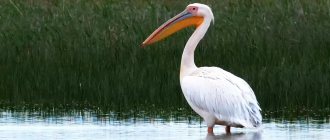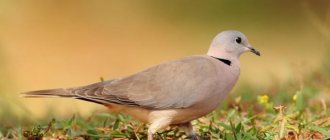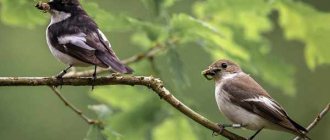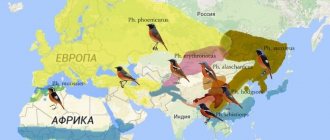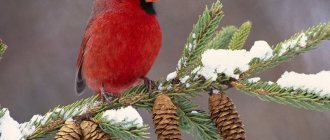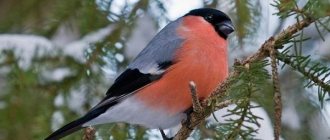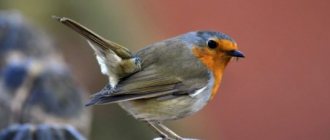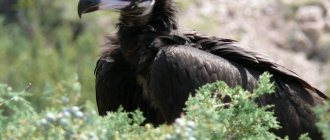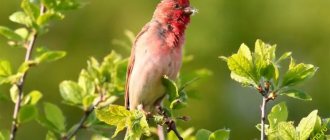| Latin name | Platalea |
| English name | Spoonbill |
| Squad | Stork-like or ankle-footed |
| Family | Ibis |
| Body length, cm | 60-80 |
| Wingspan, cm | 120-140 |
| Body weight, kg | About 2 |
| Features | The spoonbill is known for its flat beak, which is shaped like a spoon. |
| Number | 31000-34000 individuals |
| Security status | Some species have protected status in the world. |
| Habitats | They usually live in shallow waters. |
| Additionally | There are 6 species of spoonbills:
|
Description
Photo of spoonbill
The family Threskiornithidae includes 35 species of large wading birds. It is also traditionally divided into two subfamilies: ibises and spoonbills.
— Advertising —
The spoonbill belongs to the order Storkidae and is distinguished by a strangely shaped beak. The description of the spoonbill says that the bird has a large, flat, shovel-like beak. They feed by wading through shallow water, moving their open beak from side to side. The moment a small aquatic creature touches its interior - an insect, crustacean or tiny fish - the beak slams shut. Spoonbills prefer fresh water to salt water.
The social behavior of this bird varies from species to species. Some feed alone, while others live in groups. When the breeding season arrives, spoonbills gather in large numbers in one place to form pairs. Most representatives mate with one partner per season, and choose a new one the next. Some types of spoonbills breed in colonies with other bird species.
Number
According to scientific data, the number of the species is about 31,000-34,000 individuals. There are approximately 2500-3000 pairs on the territory of the Russian Federation.
Structure and dimensions
Spoonbill drinking photo
– Advertisement –
Spoonbills have elongated, flattened beaks and moderately long necks. The nostrils are located near the base of the beak so that the bird can breathe while it is submerged in water. Spoonbills' eyes are positioned to provide binocular vision—the ability to see objects clearly with both eyes at the same time. While feeding, birds also pay attention to tactile sensations.
The species have long, featherless legs, which they use to wade through shallow water. The plumage of all types of spoonbills is white. The exception is the roseate spoonbill, which has pink feathers.
The height of most representatives reaches 94-96 cm, and weight is approximately 2 kg. The wingspan of birds is from 120 to 140 cm.
Spoonbill bird: species with photos, names, descriptions
Spoonbills are wading birds that are close relatives of ibises. The elongated flat spoon-shaped beak is the most characteristic feature of the appearance of these birds, by which they can be easily distinguished from other birds living in swamps. In nature, there are 6 species of spoonbills, which differ in their distribution area and some external features.
Common Spoonbill
This is the most common species of spoonbill in Europe. The body length of its representatives reaches 1 m, and the weight varies between 1.2-2 kg. The wingspan of common spoonbills reaches 1.1-1.3 m.
The body color of these birds is snow-white, while the beak and legs are black. During the mating season, common spoonbills, like many species of herons and night herons, develop a crest on the back of their heads. Another characteristic difference in their appearance at this time is the presence of an ocher spot near the base of the neck.
The distribution range of the common spoonbill includes:
- Southern (less often Western) Europe;
- Asia;
- northern regions of the African continent.
In the vastness of Russia, these marsh birds are found in the lower reaches of the Volga, Terek, Don, as well as on Lake Manych-Gudilo. In addition, spoonbills can be seen in the south of the Krasnodar Territory, in the southern regions of Transbaikalia and the Krasnodar Territory, in Khakassia.
Representatives of the European population fly to central and eastern African countries for the winter. Common spoonbills, which live in the vast expanses of Asia, usually spend the winter in China and India.
On a note! In Kazakhstan, Ukraine, Japan, Korea and Russia, spoonbills are among the Red Book birds.
Common spoonbills live in shallow water bodies (silted rivers, freshwater and salt lakes) and swamps, as well as among mangroves. These birds form small groups. They are often located next to flocks of loon deer and herons, but not next to other species of spoonbills.
Common spoonbills make nests in reeds or on trees located above the water. They nest in separate colonies, which can number from 6 to 160 individuals. These birds usually have from 3 to 6 eggs in their clutch, which the male and female incubate alternately for about 3 weeks.
Interesting fact! The newly born chicks have a thick and soft beak. It acquires the form characteristic of adults only in the 2nd month of life.
Initially, the chicks feed on food regurgitated by their parents. They spend the first 4 weeks of their life in their parents' monastery.
Then the grown spoonbill chicks form “youth” groups with chicks from neighboring nests. They can fly independently by the end of the 2nd month of life.
The diet of the common spoonbill consists of frogs, fish fry, insect larvae, crustaceans and amphibians. These birds also occasionally feed on aquatic vegetation.
They usually hunt in small groups. The drainage of swamps and the disappearance of shallow lakes pose the main threat to the existence of the population of these wading birds.
Lesser Spoonbill
This is one of the rarest species of spoonbills. Their distribution area is extremely narrow and covers islands located near the western coast of China and Korea. Also, small spoonbills are found in the Primorsky Territory of Russia. For the winter, these birds fly to Japan, Vietnam, Taiwan, Hong Kong and South Korea.
The body length of the small spoonbill reaches 76 cm, and the weight is up to 1 kg. The plumage of representatives of this species is snow-white, and part of the head, legs and beak are black. The small spoonbill usually hunts at dusk, at low tides, looking for food in the form of small aquatic fauna in shallow coastal waters.
Due to deforestation of mangroves and environmental pollution, the number of small spoonbills in 1988-90. decreased to 288 individuals. By 2001, it was possible to partially restore the population of these birds in nature.
In 2012, there were already about 2,700 individuals of small spoonbills. But the species is still one of the birds that is threatened with extinction.
White spoonbill
This species of spoonbill is found exclusively in sub-Saharan Africa (including Madagascar), and is therefore often referred to as African. The body length of its representatives reaches 75-90 cm, and weight – up to 2 kg. The plumage of these spoonbills is snow-white, part of the head and legs are red, and the beak is gray.
These birds live in swamps and wetlands. They make their nests in trees or among reeds. Like other species of spoonbills, these birds wander through shallow water, moving their beaks lowered into the water around the sides, and catching fish, amphibians and aquatic insects that come across during such probing.
Royal spoonbill
This species of spoonbill lives in the vastness of Oceania and Southeast Asia. Countries where these birds are found include Australia, Papua New Guinea, Solomon Islands, Indonesia and New Zealand. Freshwater or saltwater wetlands and tidal flats are the primary habitats for king spoonbills in the above regions.
The body size of these birds varies between 74-80 cm, and the weight reaches 1.4-2 kg. The plumage of royal spoonbills is snow-white, and the unfeathered part of the head and beak are black.
Like their relatives, representatives of this species search for food by walking in shallow water with their beak submerged under water. As soon as they find their prey, they immediately capture it. Often, in search of prey, these spoonbills even completely immerse their entire head under water.
During the day, royal spoonbills rest, and at dusk they go hunting. They are most active at night. The basis of their diet is crabs, fish and shellfish. These birds also do not disdain plant foods.
Roseate Spoonbill
The range of this species of spoonbill covers vast areas from South America (starting from the eastern part of the Andes) to Mexico on the North American continent. These birds are also found in the Caribbean and on the Atlantic coast in the USA.
The largest population of roseate spoonbills lives in warm areas of Florida (especially the Everglades). For the winter, its representatives fly to Argentina and Chile.
The body length of roseate spoonbills reaches 70-86 cm, and the weight varies from 1.2 to 1.8 kg. Part of their back, wings and abdomen are painted bright pink or red.
Like flamingos, this coloring in roseate spoonbills is associated with their diet. Depending on the abundance of crustaceans containing carotenoid pigments in the food, the color of the plumage can vary from pale pink to deep crimson.
The head of these birds is greenish, the neck and part of the back are snow-white, and the beak is gray with a yellow spot at the base. The long legs are painted bright red.
Roseate spoonbills form large colonies in coastal waters and among mangroves. They make their nests in trees and bushes. This species of spoonbill has 2-5 eggs in its clutch.
The chicks are born after 3 weeks. Both parents feed them. After 2 months, the grown chicks become completely independent. Frogs, crayfish and newts form the basis of food for these spoonbills.
A hundred years ago this species was on the verge of extinction. Beautiful birds were exterminated for their colorful plumage, used as fashion jewelry. The feathers of roseate spoonbills were then 3 times more valuable than gold.
Currently, the threat to these birds exists only in their wintering areas. In the vastness of the United States, roseate spoonbills are among the protected birds. They are not yet in danger of extinction.
Yellow-billed Spoonbill
This species of spoonbill is endemic to Australia. They are found mainly in the southeast of the country, although individual populations also exist in other Australian regions.
Shallow wetlands, inland saltwater and freshwater reservoirs are the most typical habitats of yellow-billed spoonbills. But these birds can also be found on dry pastures.
The body length of the yellow-billed spoonbill reaches 75-90 cm. The plumage of these birds is white, and the beak and legs are yellow. During the mating season, they develop colorful long feathers on their chest.
Juveniles can be identified by their black wing tips. Males differ from females by having longer legs and beaks.
Yellow-billed spoonbills nest in separate pairs or small colonies containing only a few nests. They have 2-4 eggs in a clutch.
Chicks are born at 26-31 days. These spoonbills feed mainly on aquatic insects (in particular, smoothies), and less often on crayfish, mollusks, shrimp and small fish.
Interesting facts about spoonbills
1. In English, these birds are called “spoonbill”, which literally translates as “spoonbill” and emphasizes the characteristic feature of the appearance of spoonbills. The Latin species name “Platalea” translates as “wide,” which is also associated with the specific shape of the beak of these birds.
In the Russian expanses, the spoonbill in the old days was called the spoonbill or mower because of its method of catching prey.
2. Spoonbills are found on all continents except Antarctica. Their most extensive populations live in the Mediterranean region of Europe, near the Black, Japanese and Yellow Seas.
3. Most spoonbills form a pair only for one season, and the next they choose a different partner.
4. These birds begin to reproduce in the 3rd year of life. In captivity they breed extremely rarely.
5. Spoonbill chicks are born not one at a time, but all at once. Most often, they die not from the teeth of predators, but from lack of food.
Approximately 60% of young animals die in the first year of life during migration to wintering grounds. The main enemies of adult spoonbills include crows, vultures, snakes, foxes, raccoon dogs and wolves.
6. Migration flights for spoonbills take up to 2 months. When flying, these birds form rows and wedges in a “V” shape.
7. In nature, common spoonbills live up to 28 years. Roseate spoonbills have the shortest lifespan.
Their age rarely exceeds 6-7 years. The record long-living species of this species was discovered in Florida. Her age at that time was 16 years old.
8. In flight, the spoonbill with its neck stretched forward most resembles a stork. She flaps her wings frequently, but can also hover.
9. Spoonbills are not overly talkative. Only when you are close to these birds can you hear the quiet grumbling sounds they make.
When alarmed, they emit a loud, hoarse cry, alerting their relatives to a potential threat to life. In most cases, spoonbills feed in the vicinity of huge flocks of gulls, loaches and other noisy birds, which are the first to scream when predators appear.
10. In the Netherlands, the spoonbill is recognized as the national symbol bird of the country.
Kinds
Various types of birds live on all continents of the world, with the exception of Antarctica. The table provides a brief description of 6 types of spoonbills.
| Spoonbill species | Appearance | Spreading |
| Eurasian or common – P. leucorodia | Adults and juveniles are white, with dark beaks and legs, and black tips on the wings. It nests in reed thickets, usually without other species. | It is the most common species, found in northeast Africa, much of Europe and Asia, all the way to Japan. |
| Small or black-billed – P. minor | Similar to Eurasian birds. | They live in Taiwan, China, Korea and Japan. |
| African – P. alba | A large white species similar to the Eurasian spoonbill, but differing in its pink face and paler bills. The type nests in trees, swamps or rocks. | Found in Africa and Madagascar. |
| Royal – P. regia | Large white spoonbill with a black face. | More common in south-eastern Australia. But also lives in other parts of the continent. For example, in New Zealand, especially the South Island, New Guinea, Indonesia and the Pacific Islands. |
| Yellow-billed – P. flavipes | White spoonbill with a yellow beak. | Habitat: South-Eastern Australia. |
| Pink – P. ajaja | Birds with pink feathers and a spoon-shaped beak. | South America, Caribbean and southeastern United States. |
Common or Eurasian
Photo of a spoonbill standing by a pond
The common spoonbill is found in wetlands, where it often forages in groups. Adults have a white body, wings, tail and head. However, during the breeding season the head coloration becomes brighter, with a dark yellow collar at the base of the neck and an orange-yellow area around the base of the bill. The chin and throat are bare, bright orange. The elongated feathers on the back of the crown form a yellow crest.
The beak is long, straight, ribbed, black with an orange tip. The eyes are red. Legs and feet are black.
The non-breeding bird has a dull black beak with a yellowish tip. The face is mostly white, with a yellowish tint.
The Eurasian spoonbill lives in large wet areas such as flooded lands, rivers, swamps and ponds.
During the wintering period, the species lives in streams, river deltas and coastal lagoons. The bird nests on islands, off the sea coast, but more often near lakes or rivers.
Lesser or black-billed
A flock of spoonbills photo
The small or black-faced spoonbill – Platalea minor – is a white wading bird with a spoon-like beak. The skin on the face of the spoonbill is bare and black, which is where the second name comes from – black-headed. The body length of the species is about 76 cm, weight is about 1 kg.
During the breeding season, adult birds develop yellow feathers on the head and chest, as well as yellow spots under the eyes.
Platalea minor is the most vulnerable of all spoonbill species, as its numbers are small today. However, the bird's population trend is stable and may increase in the future.
In the early 1990s, there were only a few hundred individuals in the world, but by the late 2000s, numbers had risen to more than 2,000. The January 2016 census recorded a new high of 3,356 birds. Despite gradual recovery, the common spoonbill is a globally endangered species with vulnerable breeding colonies and deteriorating wintering grounds.
Pink
Photo of the roseate spoonbill
The body length of the roseate spoonbill is 71-90 cm with a wingspan of 120-130 cm. The bird's body weight is about 1.2-1.8 kg. Adults have a bare greenish head and a white neck. While the back and chest are dark pink, and the beak is gray.
Males and females have the same appearance, without pronounced sexual dimorphism. The only difference visible in the appearance of this bird is due to age and habitat. The range of color changes is from pale pink to purple. The feathered representatives received their pink body color due to their diet. The species' diet includes the carotenoid pigment canthaxanthin, which gives the plumage a pinkish color. Another carotenoid called astaxanthin is also found in the feathers of this spoonbill.
Links[edit]
- BirdLife International (2016). "Platalea ajaja" IUCN Red List of Threatened Species
.
2016
: e.T22697574A93621961. DOI: 10.2305/IUCN.UK.2016-3.RLTS.T22697574A93621961.en. - "Rosy spoonbill". Waterfowl Conservation
. National Audubon Society. Archived from the original on 2008-10-24. Retrieved July 23, 2009. - ^ ab Dumas, Jeannette V. 2000. Roseate Spoonbill (Platalea ajaja), Birds of North America Online (A. Poole, ed.). Ithaca: Cornell Lab of Ornithology. Retrieved November 12, 2009. (subscription required)
- ↑
Graham Jr., Frank (July–August 2001).
"Birds: a wing and a prayer." Audubon Journal
: 87–91. - Quinn, Joe. "Huntington Beach State Park in Murrells Inlet, South Carolina: Egret, Roseate Spoonbill, American Alligator". Smithsonian Magazine
. - Chesser, R. Terry; Yeung, Carol K.L.; Yao, Cheng-De; Tian, Xiu-Hua; Li Shou-Hsien (2010). "Molecular phylogeny of spoonbills (Aves: Threskiornithidae) based on mitochondrial DNA". Zootaxa
.
2603
(2603): 53–60. DOI: 10.11646/zotaxa.2603.1.2. ISSN 1175-5326. - "Life History of the Roseate Spoonbill, All About Birds, Cornell Lab of Ornithology". www.allaboutbirds.org
. - Hancock, Kushlan & Kahl (1992). Storks, ibises and spoonbills of the world
. Academic press. ISBN 978-0-12-322730-0. - Howell, CIS; Webb, S (1995). A Guide to the Birds of Mexico and Northern Central America. Oxford University Press. pp. 147–8. ISBN 978-0-19-854012-0.
- Brush, A.H. 1990. Metabolism of cartenoid pigments in birds. FASEB Magazine
.
4: 2969-2977. Fox, D. L. 1962. Carotenoids of roseate spoonbill. Comparative Biochemistry and Physiology
6: 305-310. (Mentioned on the Cornell Lab of Ornithology page). - ^ a b Howell, CIS; Webb, S (1995). A Guide to the Birds of Mexico and Northern Central America. Oxford University Press. pp. 147–8. ISBN 978-0-19-854012-0.
- "Researchers: Oldest wild spoonbill found - Care2 News Network". Care2.com. 2006-05-29. Retrieved February 20, 2012.
Royal
Royal spoonbills playing photo
During the breeding season, the royal spoonbill has a characteristic crest on the back of the head or back of the head, which reaches 20 cm in length in males, shorter in females. Breeding adults also have a creamy yellow patch on the lower neck and upper chest and a bright pink stripe along the edge of the underwings. The facial skin is black with a yellow spot above the eyes and a red spot in the middle of the forehead. Females are smaller, with shorter legs and tails.
Outside the breeding season, the crests on the back of the head are smaller, and the characteristic bright pink line is absent in the underwing area. Also during this period, the bird's plumage is less shiny and often looks “dirty.” Juveniles look like non-breeding adults, only without the crest and colored spots on the face. The young are smaller in size, with a shorter and smoother bill.
The Royal Spoonbill is more common in shallow waters.
Spoonbill Observations
In Central Europe, with the exception of the Netherlands and Austria, spoonbills are rare. This large white bird is clearly visible from a great distance. The spoonbill usually feeds in shallow waters and in the lowlands of rivers. In flight, it is easily distinguished from other birds by its long beak, which widens at the end and turns into a kind of paddle. The spoonbill flies with its neck extended, like a stork. In 1949 spoonbills nested in Moravia. In Central Europe (in Ukraine - in its south), spoonbills often stop during their annual seasonal migrations. Spoonbills spend the winter in Africa, Hindustan and China.
Yellow-billed
Yellow-billed Spoonbill in the water photo
The Yellow-billed Spoonbill is a bird with a yellow face, legs, feet, white plumage and a paddle-shaped beak. During the breeding season, the facial skin turns black and the outer wing feathers develop a black tint at the tip.
Juvenile birds are similar to adults, but have characteristic markings on the inner feathers called tertiles.
Taxonomy[edit]
Roseate Spoonbill
sometimes referred to as its own genus -
Ajaja
.
A 2010 study of spoonbill mitochondrial DNA by Chesser and colleagues found that roseate and yellow-billed spoonbills were each other's closest relatives, and the two descended from early offshoots from the ancestors of the other four spoonbill species. They considered that the genetic evidence meant that it was equally valid to count all six as belonging to the genus Platalea
or, alternatively, two
assigned
to the monotypic genera
Platibis
and
Ajaja
, respectively. However, since the six species were very similar morphologically, keeping them within the same genus made more sense.[6]
Habitat
Many people are interested in: where does the spoonbill live?
Most members of the species live in similar types of habitats. They are aquatic birds that live in shallow waters where they roam in search of food.
Photo of a flock of spoonbills
Although spoonbills are more common in fresh water, they can also live in brackish water. Some of the preferred habitats include swamps, wetlands, mangroves, swamps, lakes, ponds and mud flats.
WHAT DOES IT EAT?
Spoonbills hunt at dusk. You can often observe how a whole colony of these birds in a disorderly flock goes to the shallow water located nearby. In the twilight, the white silhouettes of birds have a somewhat frightening appearance. Spoonbills feed in shallow water. Long legs allow spoonbills to enter water to a depth of 50 cm. The birds walk slowly, carefully rearranging their limbs so as not to scare away their prey. Spoonbills plunge their long, blade-shaped beaks into the water, moving them from side to side, and catch living creatures that swim in the water column. The movements of the beak from a distance resemble the movement of a mower, which is why the Ukrainian name for these birds comes from this. Spoonbills usually feed in the water, but they do not miss the opportunity to make money on the shore, catching up with their prey with quick steps.
Spoonbills feed on a variety of foods. The composition of the menu depends on the habitat, region, time of year and even the body of water in which it hunts. The spoonbill catches aquatic insects in the water, such as swimming beetles, caddis flies and dragonfly larvae. In addition, this bird loves to eat mollusks, crustaceans and small fish, in particular thorns. Often the spoonbill's diet also includes worms, tadpoles, frogs and algae.
Nutrition
Spoonbills scream photo
These birds have specialized beaks that are designed for catching food. When hunting, spoonbills wade through shallow waters and swing their beaks back and forth across the water and mud. When birds sense food nearby, they immediately grab it.
The feathered representatives eat various types of food, including small fish, snails, insects, shrimp, crabs and some plants.
WHERE DOES IT LIVE?
Spoonbills live in thickets along the shores of bays and at river mouths. Sometimes single birds are found, but more often spoonbills live in colonies of up to 50 individuals. The birds hunt together in open, shallow water. Long-legged spoonbills prefer small lakes and reservoirs with a slow current and a muddy or sandy bottom, where they find a sufficient amount of food and feel safe. In Western Europe, spoonbills nest in two isolated areas: in the Dutch IJsselmeer and in Coto Donana, a national park in southern Spain. Here they are protected. Spoonbills stay along the shores of both fresh and salt water bodies; the birds give particular preference to the waters of the sea coast, where there is a change in tides. When nesting, spoonbills prefer coastal bushes, in which they can safely incubate eggs and raise offspring. In the spring, numerous flocks of spoonbills fly to nesting sites, which are located in river mouths suitable for these birds and on the banks of reservoirs protected from the wind. They also nest in swamps.
Reproduction
As far as we know, spoonbills mate for one season. However, ornithologists have not yet come to a common conclusion, so observations continue. Most species nest in trees or reed beds, often with ibises or herons.
The male collects nesting material - sticks and reeds, and sometimes takes it from an old nest. The female weaves all of the above into a large, shallow bowl that varies in shape and structural integrity, depending on the species.
Spoonbill family
The expectant mother lays a clutch of about 3 smooth, oval white eggs, which are then incubated by both parents.
The chicks hatch one at a time, not all together. The young are blind and cannot take care of themselves right away, so the parents feed the babies. Feeding of the offspring continues for another 2-3 weeks after the family leaves the nest. The main cause of brood death is not predation, but starvation.
Lifestyle
The spoonbill is usually active at dusk, but often feeds during the day, mainly in shallow waters. If birds feed in a flock on a stagnant body of water (for example, on a lake), then their movements are chaotic, but in the river they line up in an oblique line and move upstream, catching various invertebrates, tadpoles, frogs, and small fish. Sometimes spoonbills include plant foods in their diet. Wolves, foxes, and raccoon dogs are the main enemies of adult birds; snakes can destroy eggs or chicks.
It nests in colonies, sometimes together with ibises, ibises and herons - from 5 to 150 individuals. Looks for food in shallow water. The depth to which the beak can plunge depends on the length of the legs, but not more than 35 cm.
Migration
Photos of spoonbills huddled together in a flock
Along the way, spoonbills rest in different places to gain strength. Rest areas are vital for migratory birds, since the longer the journey, the longer the individual must gain strength. The total migration time takes up to two months. When migrating to Africa, about 60% of the young die from hunters, predation, exhaustion, and also from electrical wires.
At the beginning of February, spoonbills set off again from winter regions.
Enemies
Predators do not attack adult individuals due to their large size. Young chicks are preyed on by crows, vultures, snakes and mammals.
The biggest threat to any spoonbill, whether nestling or adult, is loss of habitat. This is a result of increasing human encroachment on the birds' natural habitat for agricultural purposes. As a result, spoonbills have less space to nest, breed, and catch fish to feed themselves and their young.
Population
The number of spoonbills in Russia is declining; moreover, only the periphery of its distribution area enters the territory of our country. The spoonbill lives in the Eastern Azov region, in the Northern Caspian region, in Tuva and in Southern Primorye (on Lake Khanka). In total, 1.6-2.3 thousand pairs nest in the Azov-Caspian region, and in the east of the range the number is measured in tens of pairs.
Until the middle of the 19th century. In the main habitat areas, the spoonbill was a very common species. A sharp decrease in its numbers occurred due to the regulation of river flows and massive water withdrawal for irrigation, which led to a reduction in the areas of open shallow waters - the main feeding areas of spoonbills. Storms cause great damage to nesting areas of spoonbills, causing erosion and flooding of coastlines. Sometimes bird colonies are disturbed by people, which causes clutches and chicks to die. It happens that spoonbill nests are attacked by predators - herring gulls and hooded crows. Finally, there are known cases of poaching and the death of colonies as a result of burning reeds.
Spoonbill in the Red Book
Spoonbill in water photo
The common spoonbill is listed in the Red Books of Russia, Ukraine, Kazakhstan, Japan, and Korea. The Eurasian spoonbill is listed as “least concern” in the Red Book of the International Union for Conservation of Nature and Natural Resources.
The small spoonbill (Platalea minor) is listed as an endangered species in the Red Book of the International Union for Conservation of Nature and Natural Resources.
External links [edit]
| Wikimedia Commons has media related to Roseate spoonbill . |
| Wikispecies has information related to Platalea ajaja . |
- Field Guide on Flickr
- "Rose Spoonbill Wednesday". Online collection of birds
. - Roseate spoonbill photo gallery at VIREO (Drexel University)
- Roseate spoonbill species count in Neotropical Birds (Cornell Lab of Ornithology)
- Species Count - Cornell Lab of Ornithology
- Interactive map of the range of Platalea ajaja on IUCN Red List maps
| Taxon identifiers |
|
Interesting Facts
Photo of spoonbill in flight
- In the word “spoonbill” the stress is placed on the syllable with the letter O – spoonbill.
- Salt marshes are the main breeding ground for spoonbills. The downside is that they overflow every 2-3 years during storms and high tides. If this happens during the breeding season, the eggs are destroyed and the chicks, which cannot reach the shore, drown.
- The name spoonbill comes from the Russian word for cap.
- The birds are closely related to ibises, whose fossils date back 60 million years.
- The average spoonbill is the size of a human child.
- Previously, other names were applied to the species, for example, spade, spear, mower.
- African spoonbills are typical introverts. Birds are shy and prefer to communicate with their own kind. If a person gets too close, the spoonbill will always fly away.
- Feathered representatives live in small groups of three to five individuals. But this flock can be located in a larger concentration of up to 1000 birds, including not only their own kind, but also herons, ibises and flamingos.
- Spoonbills do not have a specific distinctive sound. When someone is close, they give an alarm to their comrades by emitting a loud, hoarse screech.
- Spoonbills have been called one of the most egalitarian species on the planet because the birds share all responsibilities between men and women. Apart from anatomical differences, which are not visible without careful study, there are no obvious external differences between males and females.
- The oldest wild roseate spoonbill was discovered in the Florida Keys in 2006, when it was 16 years old. The previous longevity record for the species was seven years.
- Roseate spoonbills nearly became extinct in the 1800s because their feathers were used to make women's bonnets and fans.
- The roseate spoonbill makes strange guttural noises when eating.
- The species' nostrils are located at the top of the beak, allowing the bird to breathe while it is underwater.
- The Eurasian spoonbill has three subspecies: 1) P. leucorodia - found in southern Spain, Holland, southeastern Europe, central and eastern Asia, southern Africa, the Persian Gulf, India and Sri Lanka; 2) P. balsaci - lives on the islands off the coast of Mauritania; 3) P. archeri - found on the coasts of the Red Sea and Somalia.
- The Little Spoonbill is the only critically endangered species that has the most limited geographic distribution.
CHARACTERISTIC FEATURES OF THE Spoonbill
Nest: built from the stems of reeds and other marsh plants, lined with leaves and grass. Parents feed the chicks with semi-digested food.
Search for food: the spoonbill moves its spatula-like beak, widened at the end, through the water from side to side and catches small animals.
— Spoonbill habitat
WHERE DOES IT LIVE?
The discontinuous range consists of isolated areas in the Netherlands, Central and Southern Europe, North Africa, southern Russia, India and Sri Lanka.
PROTECTION AND PRESERVATION
Spoonbill nesting sites are in danger and are threatened by drainage. The IJsselmeer in the Netherlands and the Austrian lake Neusiedlersee, the European breeding grounds of the species, are protected.
